A New Era: Indigenous Identity & Empowerment at SWAIA Native Fashion Week
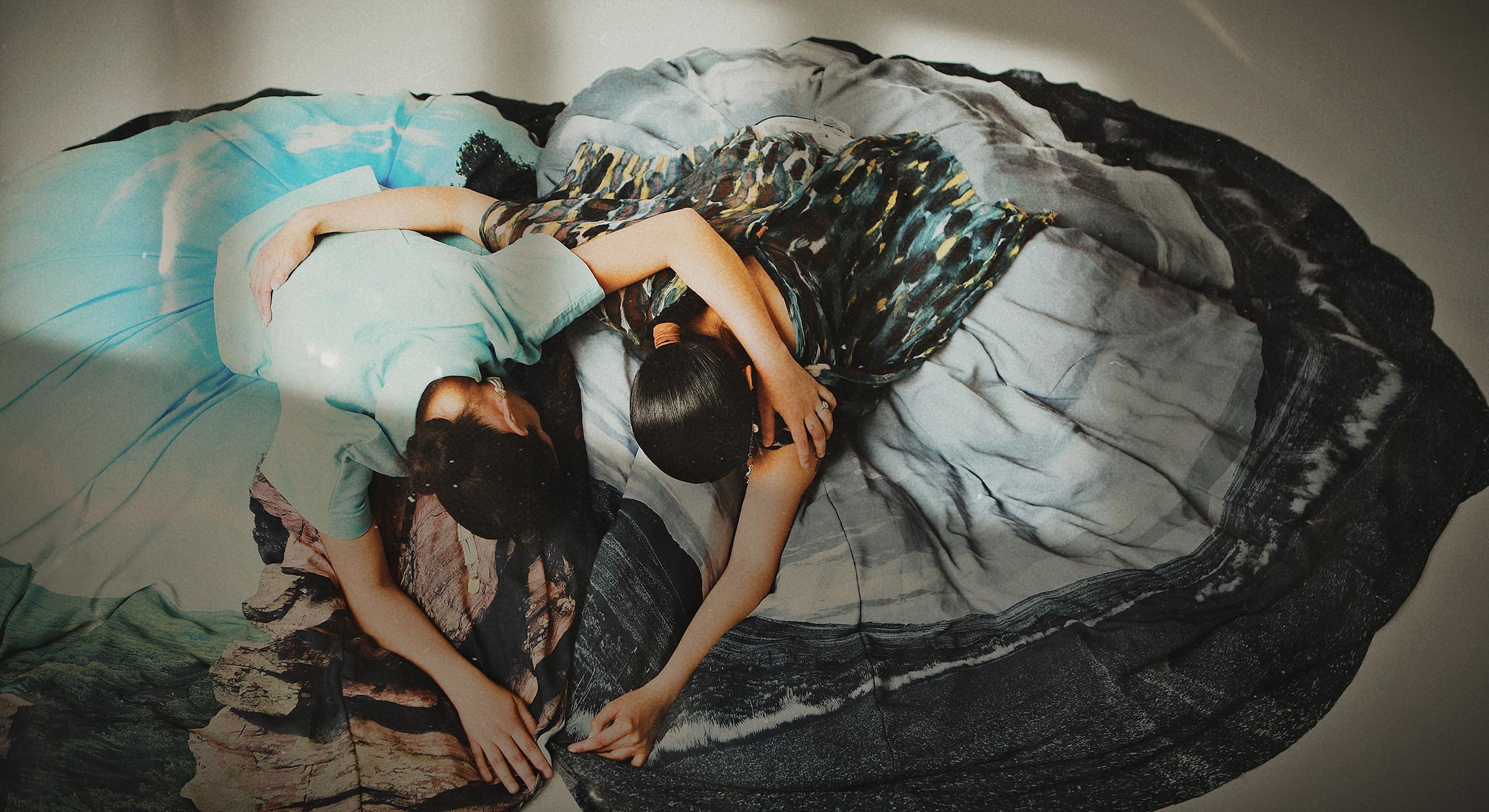
Photo Credit: Zoe Urness
Loading the Elevenlabs Text to Speech AudioNative Player...
From May 7th through 11th, the Southwest Association for Indian Arts, SWAIA, hosted their second annual Native Fashion Week event in Santa Fe, New Mexico in partnership with Vancouver Indigenous Fashion Week, VIFW. Originally founded in 1922, SWAIA is known for the Santa Fe Indian Market, an annual weekend event in August dedicated to showcasing the finest Native American art and craftsmanship, bringing in over 1,000 Indigenous artists from over 200 tribal nations each year.
"Ultimately, SWAIA is dedicated to creating economic sovereignty and career pathways for the artists we work with." Stated Jamie Schulze, executive director of SWAIA, in a brief interview.
Now in its second year, the SWAIA Native Fashion Week offered more than a showcase of garments. It stood as an affirmation of Indigenous presence, a cultural resurgence in motion. The fashion week has only grown in popularity, with over 20 designers from across North America, including several talented artists from Canada, presenting runway collections and pop-up events.
"Vancouver Indigenous Fashion Week and SWAIA are coming together to unite Indigenous fashion from North and South, telling our stories through art, culture and design. Through this partnership, we celebrate the revitalization of our traditions, the strength of our communities, and the power of fashion as a living expression of our identities" - Caroline Phelps, VIFW
The week served as a living canvas of tradition, storytelling, and innovation; it shows us that we are bearing witness to an Indigenous Renaissance.
"When people think of native fashion, they tend to envision ceremonial or powwow regalia, but there’s also so much more than that," said Schulze.The fashion week events began on Thursday with panel discussions at locations throughout the historic Santa Fe Plaza. The panels were led by academics and designers. The topics ranged from issues such as public health in Indigenous communities, to sustainability, innovation, and the future of Indigenous design in the fashion industry. The evening continued at the Governor’s Mansion in the Sangre de Cristo foothills, where designers, models, guests, and media had a chance to interact ahead of the weekend’s runway events.
It was pouring rain as guests arrived at the mansion. The house itself was warm and opulent, filled with people from all corners of North America, dressed in the finest bespoke tailoring, silver jewelry, furs, and beadwork. Room to room, the guests spoke with one another, some of them reuniting for the first time in several years.
"When people think of native fashion, they tend to envision ceremonial or powwow regalia, but there’s also so much more than that," said Schulze. "The reality is, Santa Fe has always been a major regional trade hub, and people have always dressed in their finest to come here."
I met Odo Ishkiin, an intern with SWAIA. He wore an upcycled Carhartt jacket, screen printed with his own design. Originally from Portland, Oregon, Odo came to Santa Fe to study with the Institute of American Indian Arts.
As the rain showers ended, a rainbow appeared in the mountains and people began to pour out into the surrounding grounds to get photos in the golden hour light. As I walked through the crowd, I came across Dene designer Tishna Marlowe of Dene Couture, arm in arm with Douma Alwarid of Unorthodox Yukon. Tishna was dressed in a black mesh top and trousers, Douma wore a red gown and was draped in a fur piece by designer Randi Nelson.
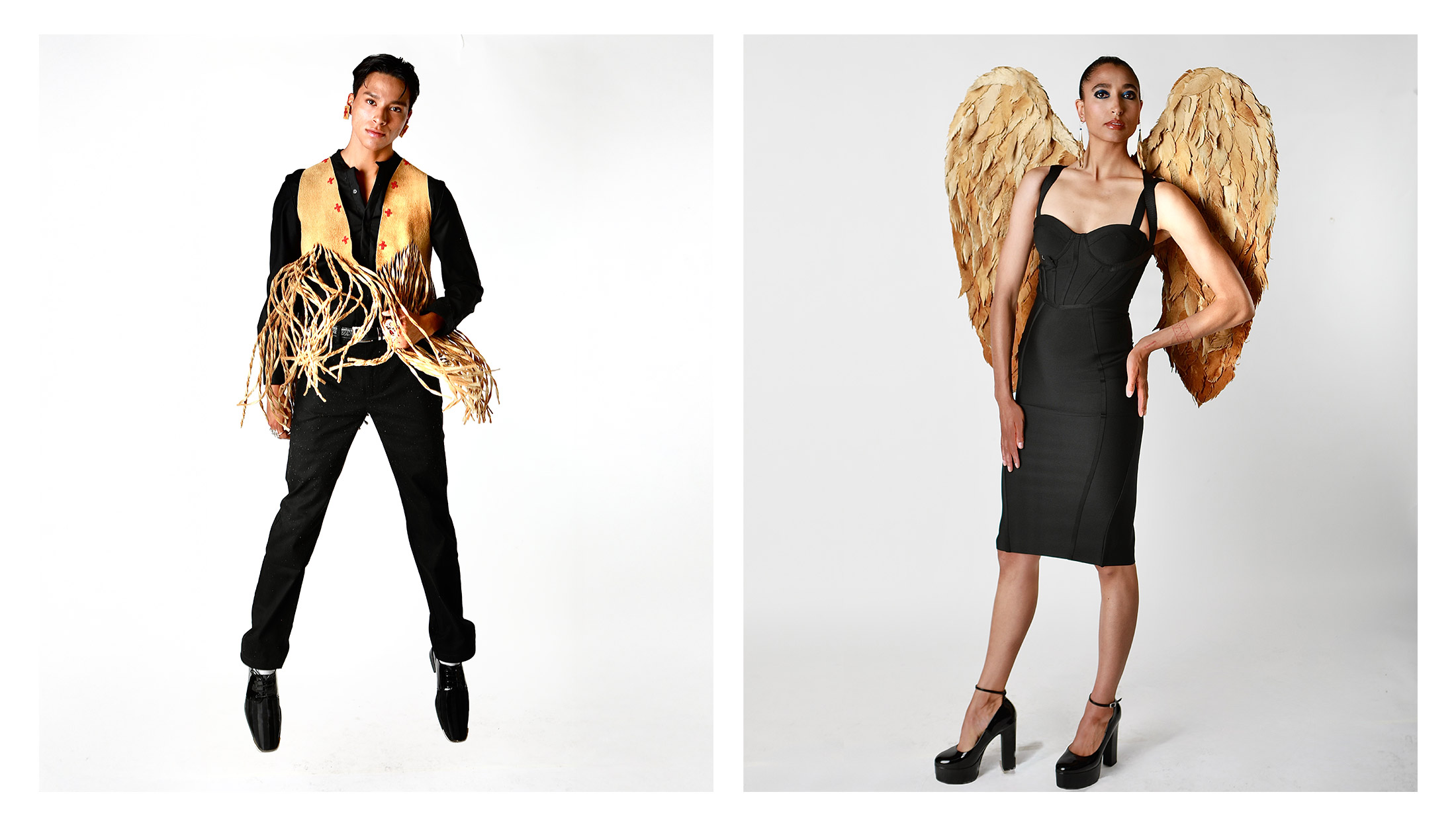
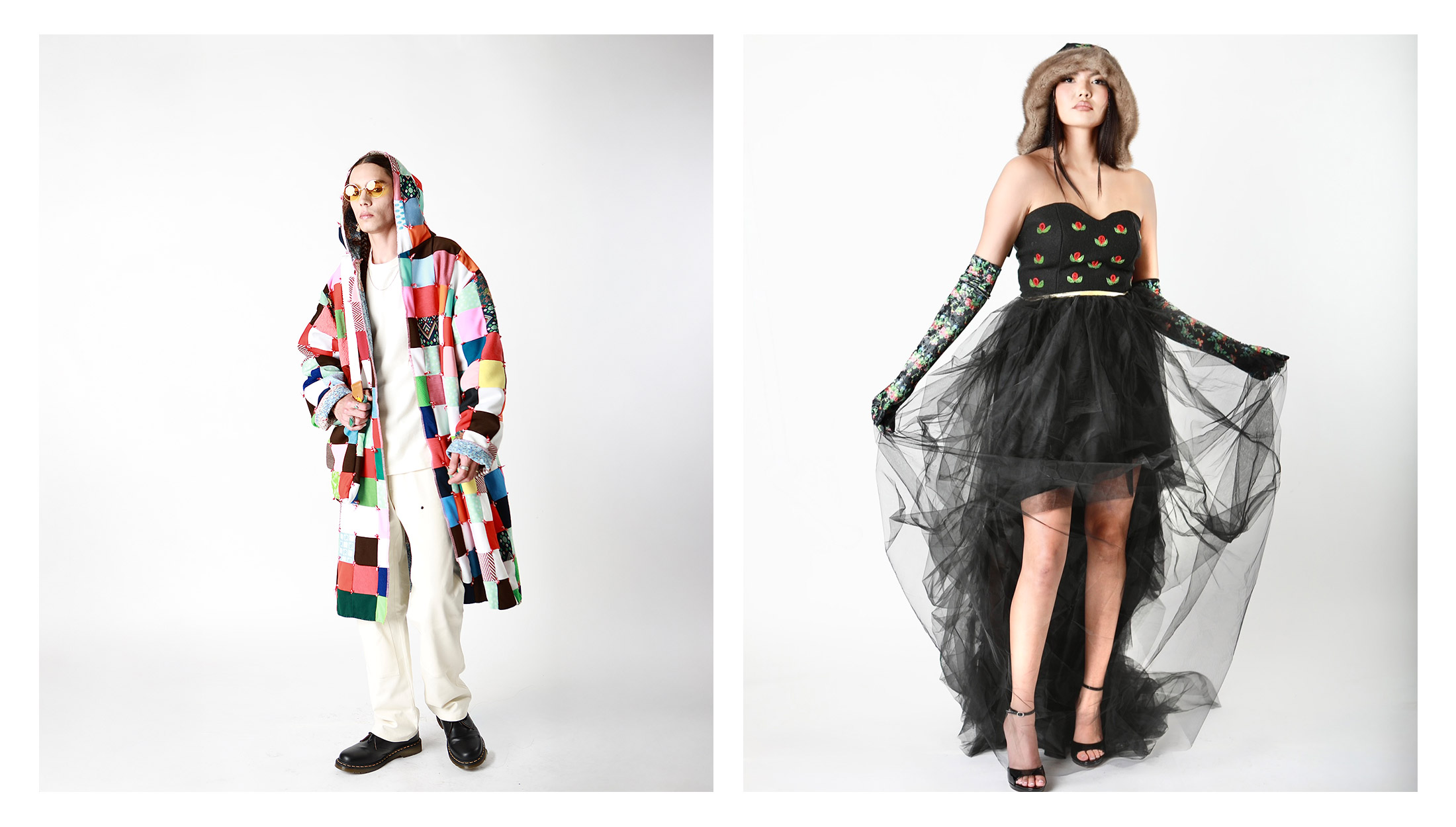
Tishna spoke about her upcoming Friday runway presentation, Dene Couture Heirloom Collection, and the future of Indigenous fashion overall. "I truly believe we are in the midst of an Indigenous Renaissance." she stated, looking at the crowd around us.
"This collection is a silent story of the growth of a genealogy." - Tishna MarloweThe runway events began on Friday evening, featuring presentations from Dancing Storm Designs, Stitched by April, Dene Couture, Sage Mountain Flower, Randi Nelson Designs, and Lauren Good Day. Inuk designer April Allen of Stitched by April presented a narrative story through her collection, accompanied by a live performance by Inuk-Mohawk throat singer Beatrice Deer. Randi Nelson’s Scwet̓mín̓ (Hide) Couture Collection consisted of traditionally tanned hides and furs, arranged in contemporary silhouettes.
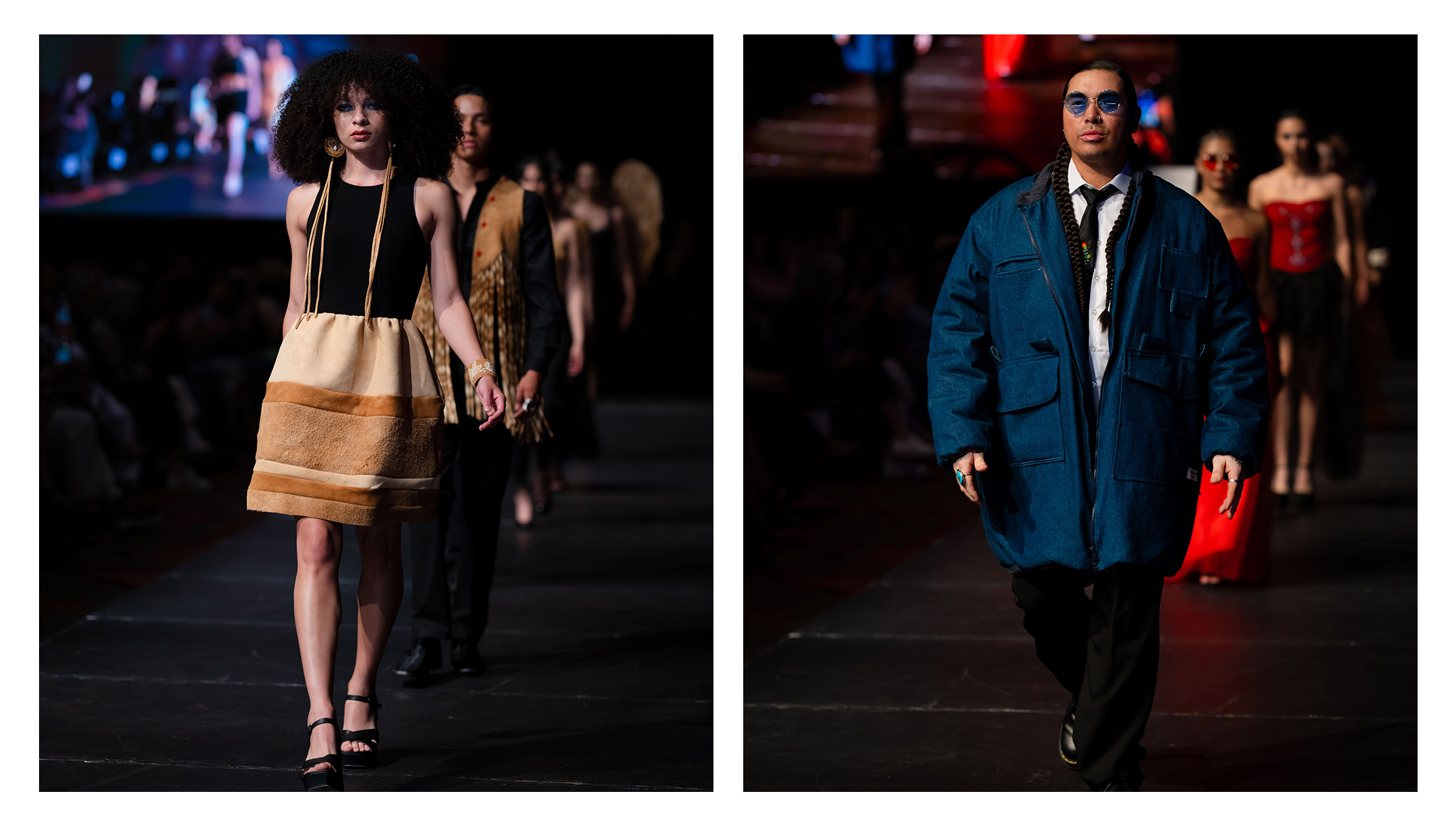
Dene Couture, by Tishna Marlowe, presented a multifaceted collection, titled Dene Couture Heirloom Collection, distinguished by warm tones and rich textures. The final three pieces were characterized by featherlight skirts and structured bodices, embellished with intricate floral designs. When asked about her presentation, Tishna Marlowe explained the collection as an homage to her own matriarchal lineage. "This collection is a silent story of the growth of a genealogy."
She also spoke about the amount of time poured into each piece. "I bead everything from scratch. I don’t use patterns, which is why it’s couture. The corset alone on only one of my gowns took me over 5 weeks to complete."
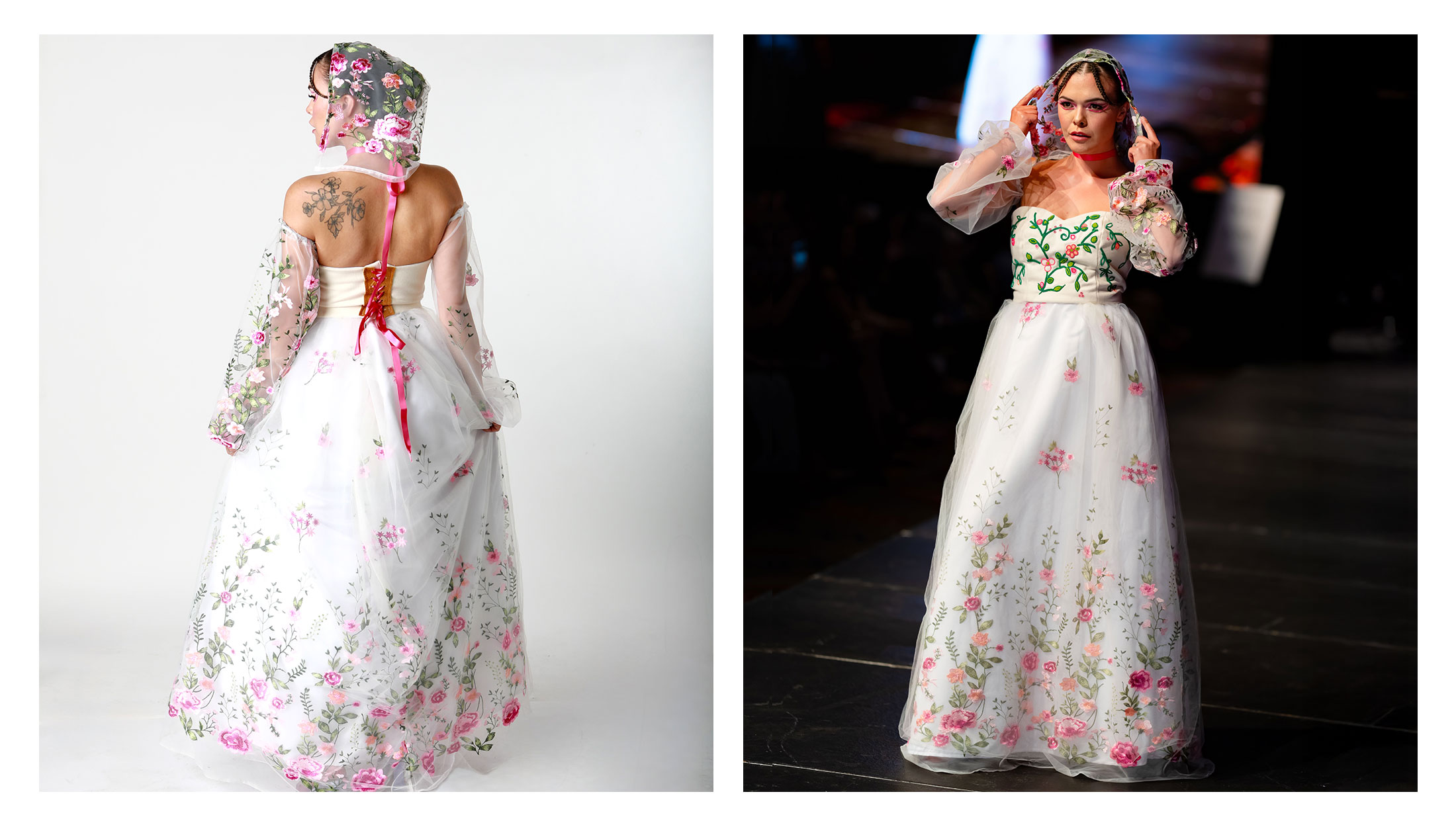
Tishna Marlowe is Chipewyan, from an isolated community known as the Lutselke, ‘Place of the Small Fish,’ deep in the Northwest Territories in Canada. She was awarded the 2025 Banff Fleck Fellowship, and her residency will begin in September. "I consider myself a bridge between the old ways and the new. I am at a place in my life where I want to challenge myself to learn more technical skills to work with contemporary designs and blend it with the traditional skills that I have."
Marlowe dedicated her collection to her grandmother, Madeline Marlowe, and great-grandmother Marie Casaway. She explained that she was communally raised. "No matter where I went, there were beads on the table, hides, furs. My grandmother told me that as soon as I could crawl, I went right to the beads."

The Saturday afternoon runway show was characterized by powerful and hard-hitting presentations by Sacrd Thndr, VIVIDUS by Tierra Alysia, Snowfly, and Wabanoonkwe x Jennifer Younger.
VIVIDUS by Tierra Alysia presented a collection titled THUNDER ARRIVES, which was preceded by a message to the audience: "We are gathering across our lands, faster and stronger than ever before. Like a storm coming down from the heavens, we cannot be stopped."
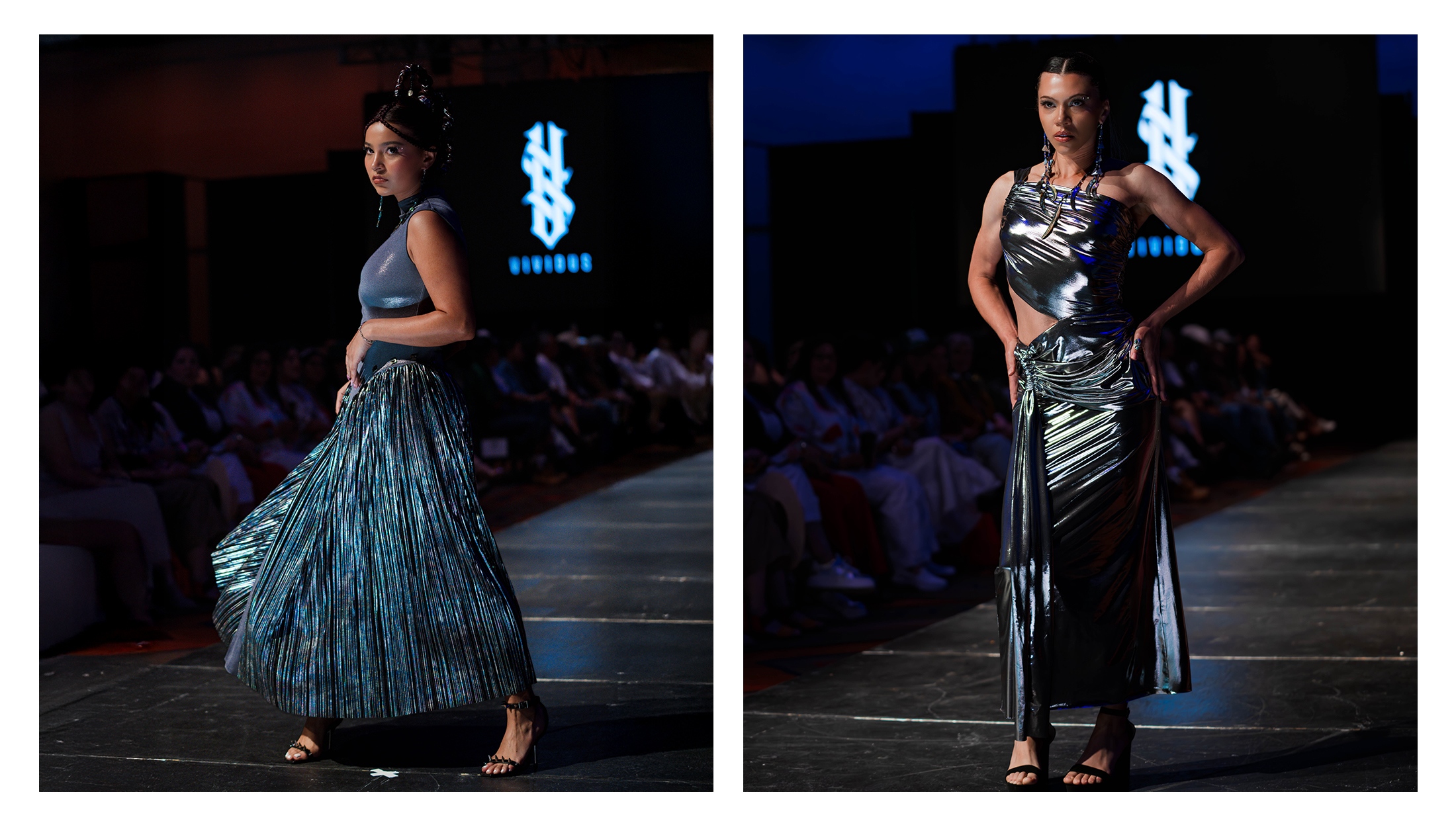
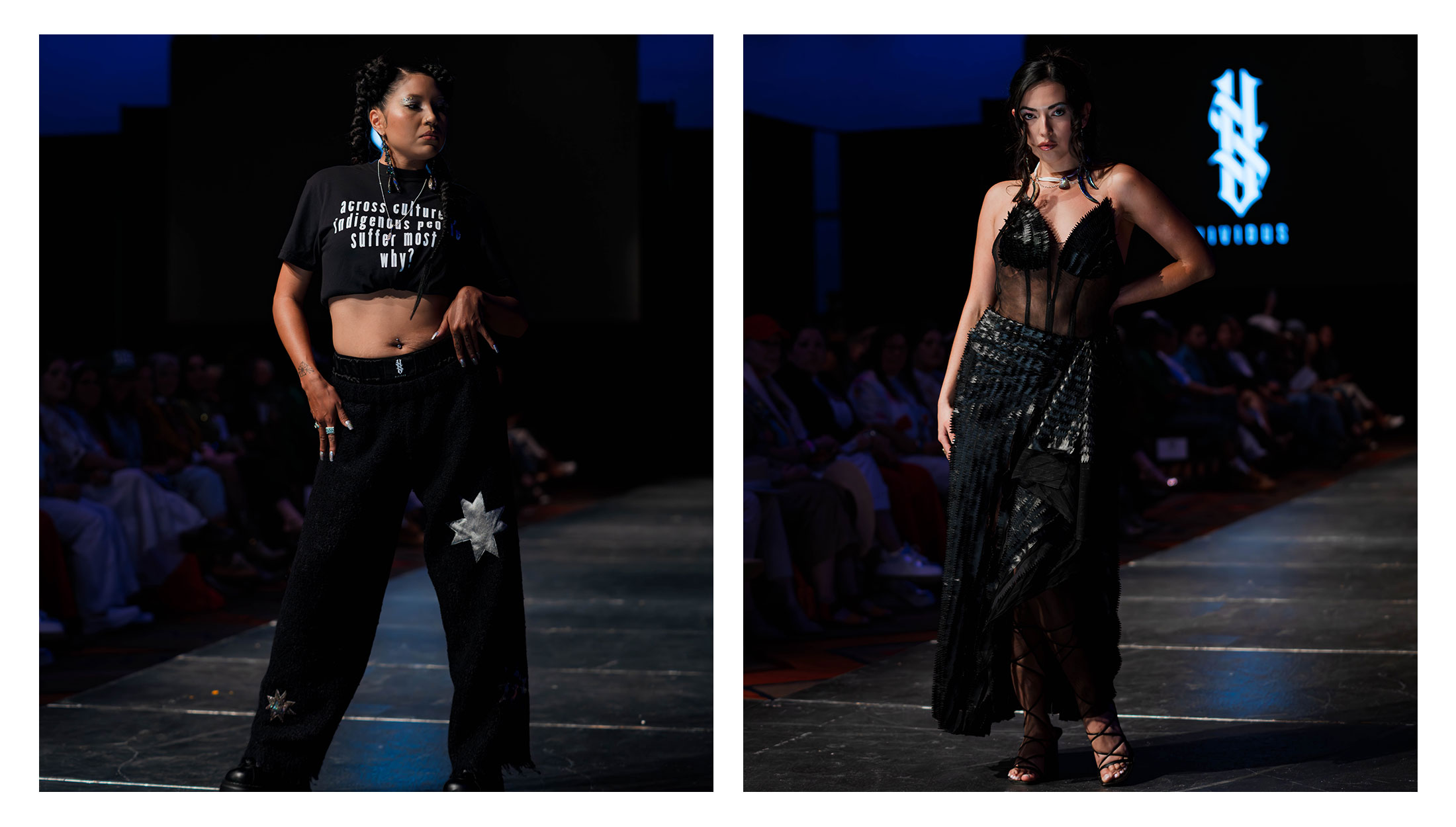
The collection incorporated black, blue, and metallic hues along with sharp angles and beadwork to create a texturally rich body of work with a powerful message.
Snowfly, by Métis designer Cheryl Fennell, presented a vibrant collection with an arctic flair, featuring a blend of traditional and contemporary silhouettes, accompanied by a hazy psychedelic rock track. Each piece carried itself, but the icing on the cake was the final look: a copper toned embellished knee length dress, fur boots, and a shawl made of colorful metallic scales. The shawl glinted in the light, making a pleasing jingling sound as the model danced down the runway, appearing as though in flight.
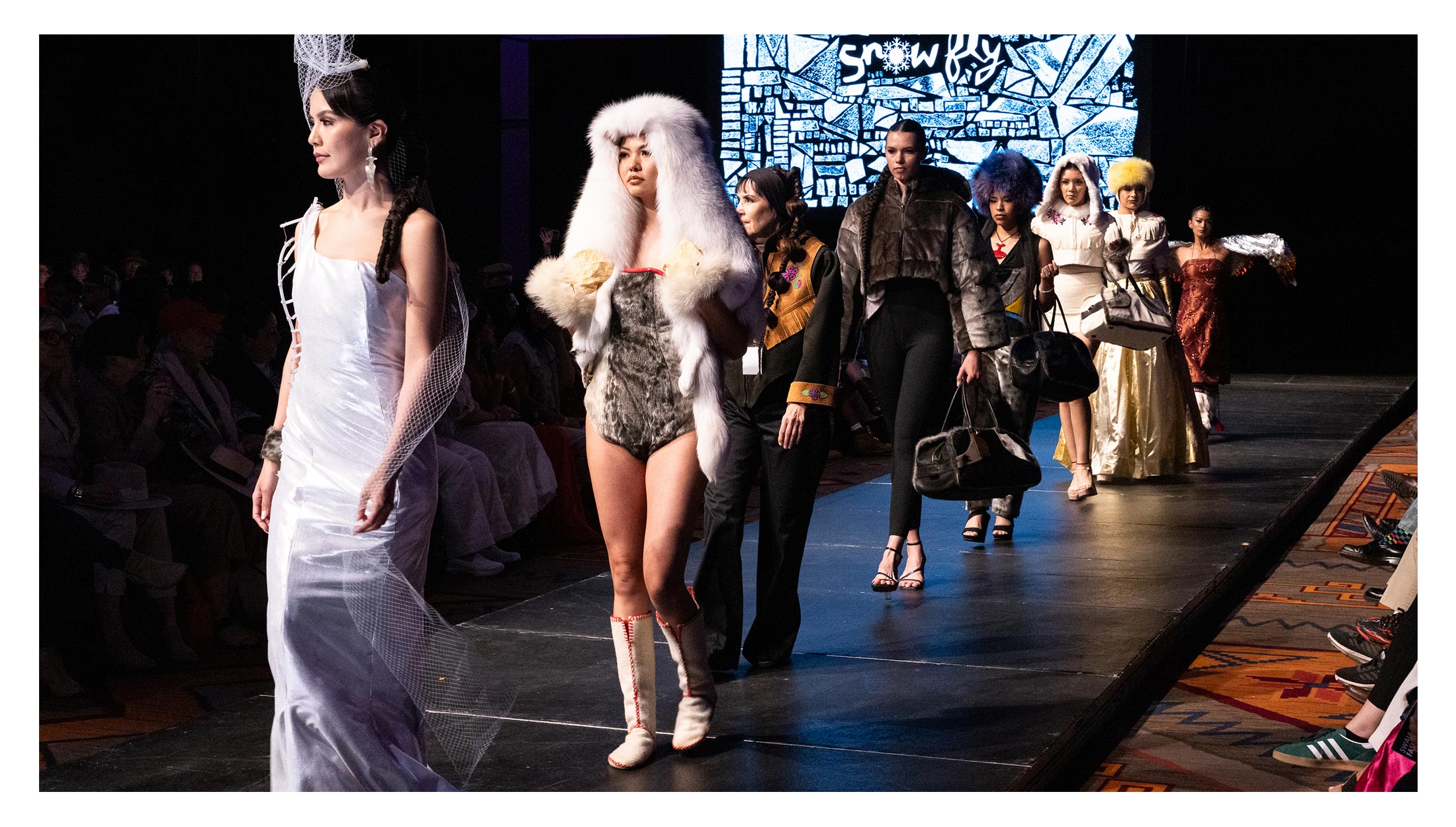
Wabanoonkwe, in collaboration with jewelry designer Jennifer Younger, showed a powerful collection titled Water Stories. The presentation brings attention to the communities of Wabasseemoong and Grassy Narrows, which have been facing devastating effects of mercury poisoning from industrial discharge for decades.
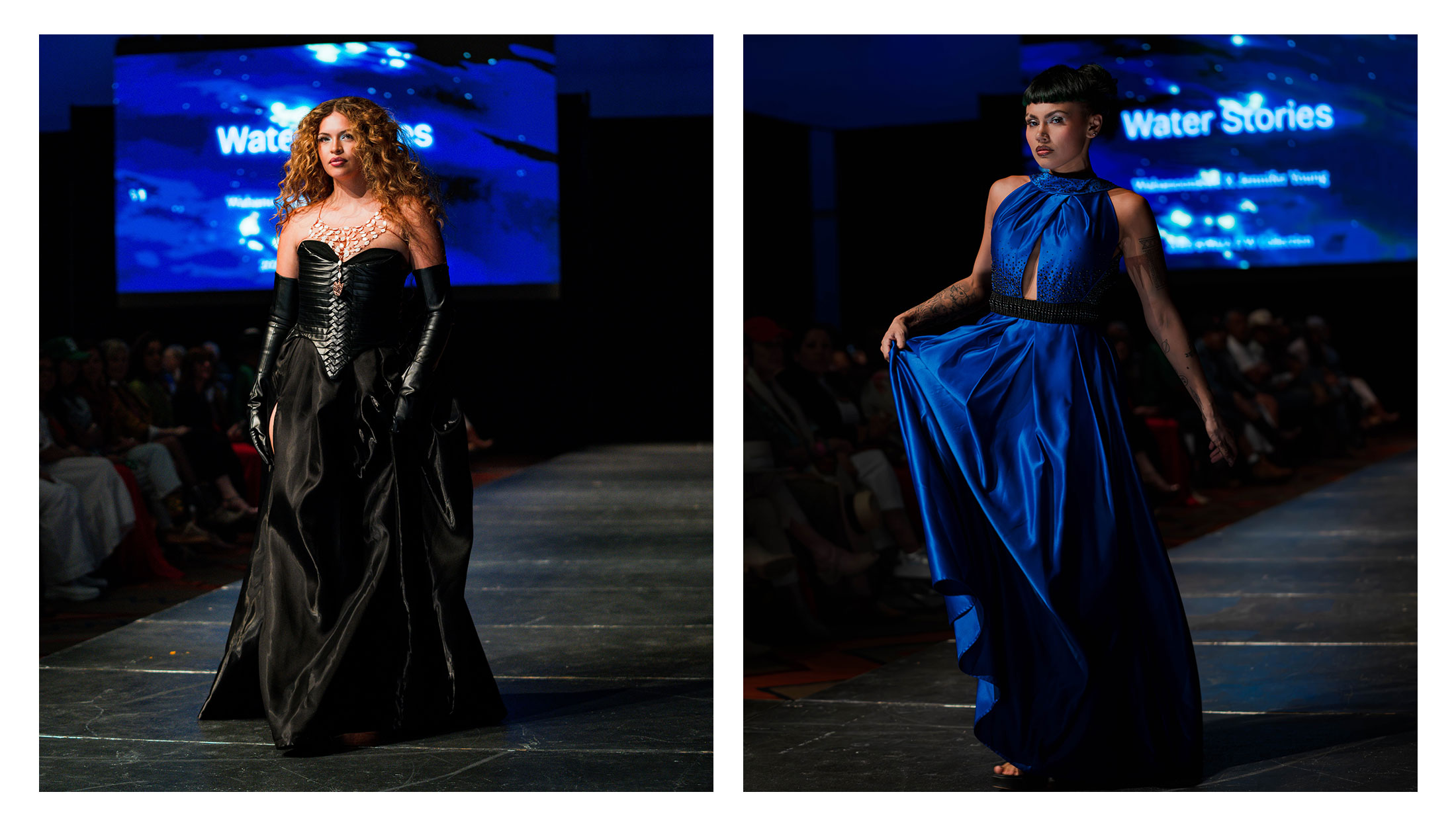
The runway looks featured silky, billowing gowns in various shades of black, blue, and white. The final look, a white gown and regal coral cape with a floral headpiece, was worn by model Sharn Maree Cassady (Ngāpuhi/Te Whānau-ā-Apanui) from New Zealand.
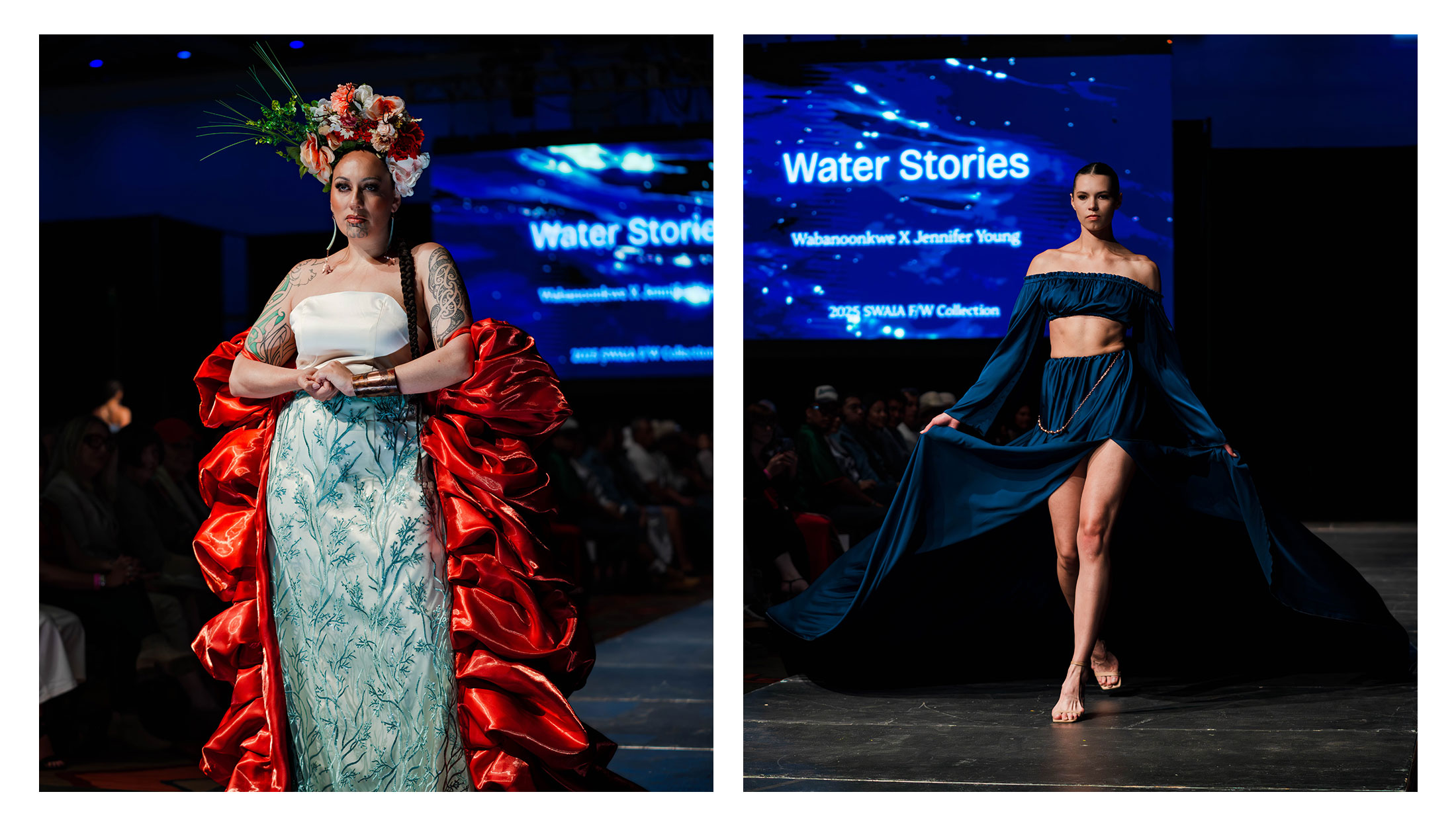
The evening runway featured collections by House of Sutai, Lesley Hampton, Ally's Ribbons, and TOC Legends. The show began with a speech and captivating performance by Cree hoop dancer James Jones, also known as Notorious Cree, which brought a vibrant energy to the remainder of the evening.
Lesley Hampton’s presentation was the most anticipated of the night. The 12-look collection, titled Obsidian: Lumina, began with bright pinks, soft and buttery textures, and unmistakable pleated skirts, a trademark of the brand. As the presentation progressed, the looks became characterized by darker, metallic hues and sharp silhouettes.
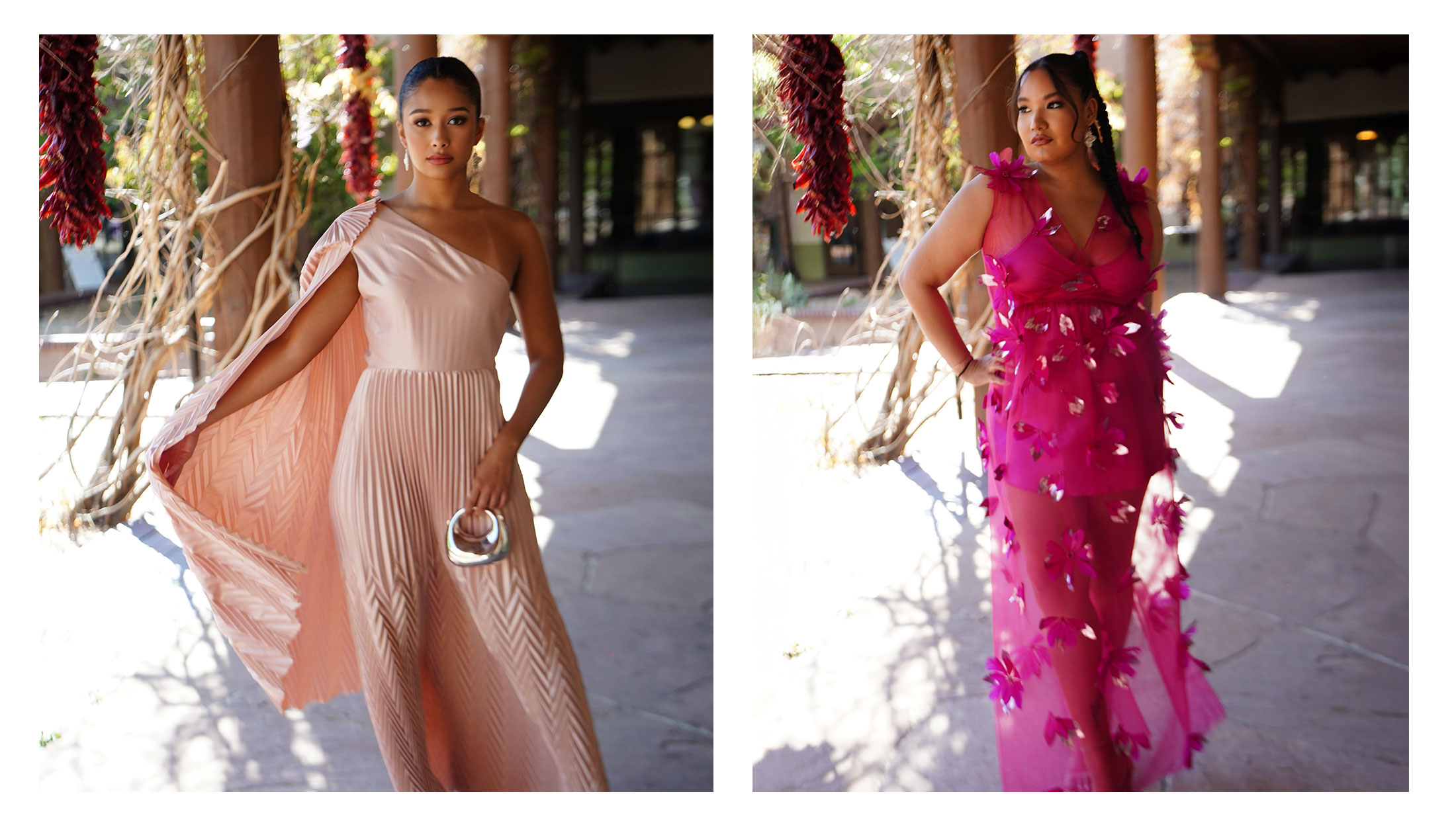
Earlier in the day, I had the chance to sit down and talk with Lesley about the collection. She said she had wanted this collection to be a representation of her journey in the fashion industry since starting her brand at the age of 22. "I was almost naive in thinking that I could come into the industry, especially the mainstream fashion industry, and be able to bring more inclusion and Indigenous representation… this collection reflects the naive innocence that I had when I started."
She explained her use of color and fabric, stating that the light pinks and flowy materials help to convey the innocence of her younger self, whereas the dark colors and hard lines work to convey a more mature, hardened version of herself.
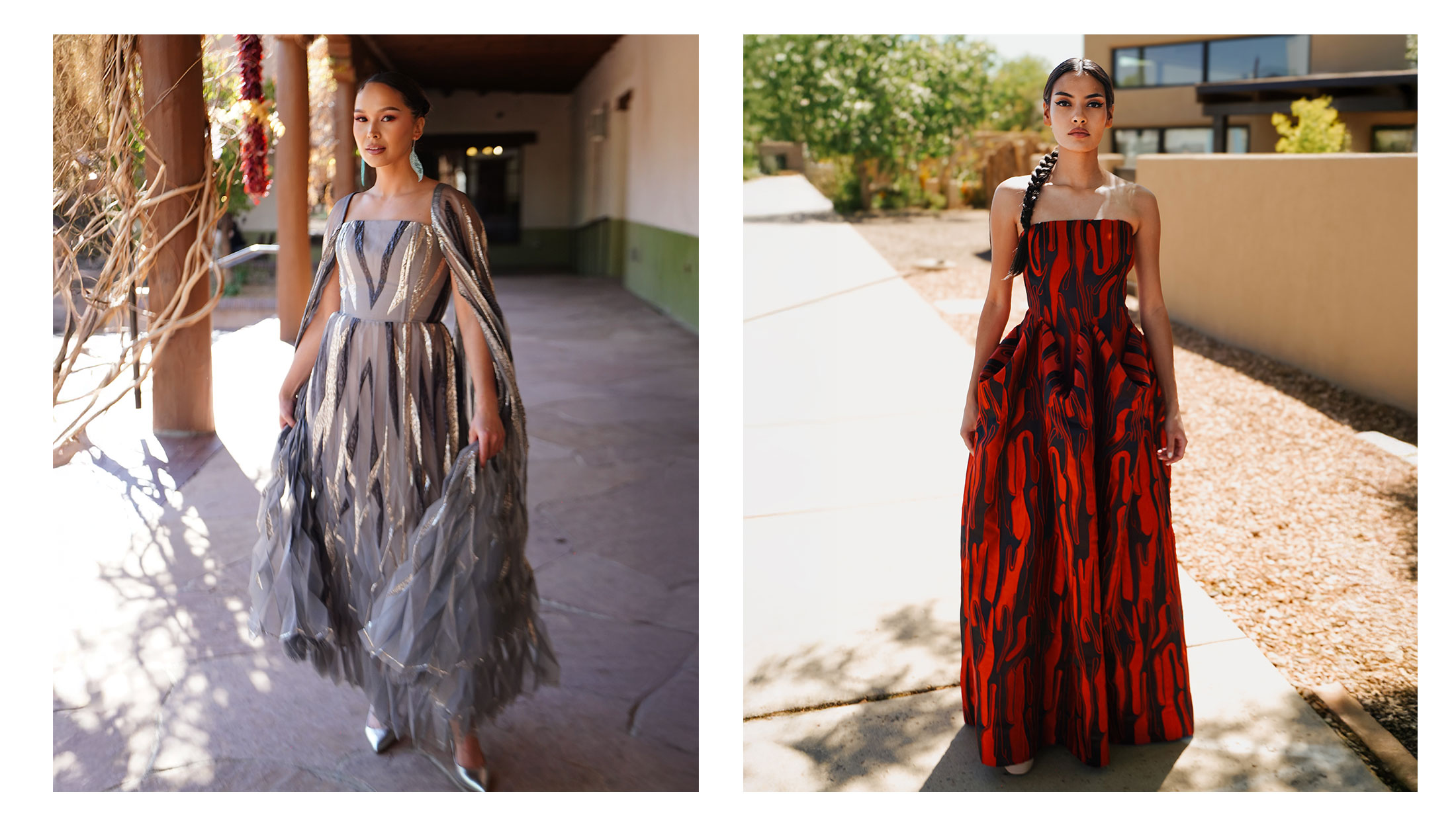
As an Indigenous designer who wanted to create clothes for diverse bodies, Hampton stated she faced a lot of pushback early in her career. "It was a slow change at the beginning… but I’m really happy with how it is now. We are able to cast diverse, and there are other designers casting diverse. We’re all able to show, not only that all bodies are included in this space, but we as designers are actually working towards that."
James Jones opened the Sunday afternoon show with another Hoop Dance performance, this time accompanied by youth dancers with Lightning Boy Foundation, a local nonprofit founded in honor of Valentino 'Tzigiwhaeno' Rivera, a young dancer who lost his life after a tragic accident. Lightning Boy Foundation operates throughout the Tewa Pueblos of Northern New Mexico, giving local youth opportunities to learn traditional art forms and dance styles.
The afternoon runway presentations followed the hoop dancers’ performance, featuring collections by Towering Stone, K Lookinghorse, Kaylyn Baker Designs, Suglit Lukxs Designs, and Copper Canoe Woman. Towering Stone, by designer Loren Aragon of Acoma Pueblo, presented a collection of everyday luxury menswear. Standing Rock Sioux designer Kayla Smith, of K Lookinghorse, presented her 2025 collection titled Painted Skies. K Lookinghorse’s final look was a gown famously worn by model Quannah Chasinghorse during 2024 NYFW.
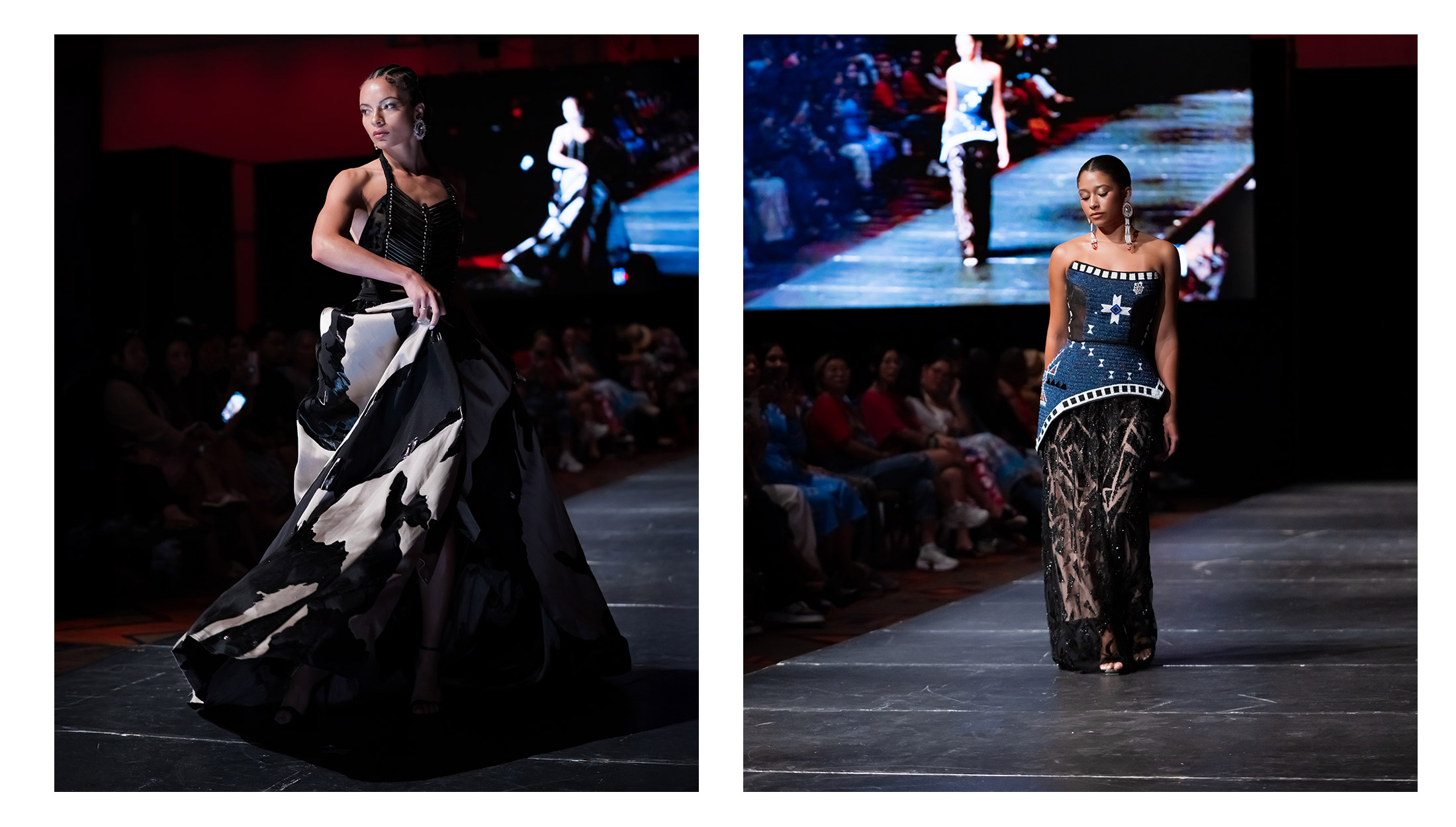
"An evolution of my last collection, Written in the Stars, Painted Skies delves deeper into Ready-to-Wear and Streetwear adaptations of these stories. The Written in the Stars collection highlights the Kapemni philosophy—'What is on earth is in the stars, and what is in the stars is on earth'—giving life to the idea that what is above reflects what is below."
The final runway event on Sunday evening featured presentations by RVSO78, Stevens & Snyder, Robyn McLeod, and PM Waterlily. It was the liveliest show by far, beginning with a performance by singer Mato Wayuhi (Reservation Dogs), joined on stage by James Jones and Tohono O’odham dancer Ba’ac Garcia of Red Boy Productions. During the performance, audience members stood and danced, while some of the SWAIA and VIFW staff hugged, danced, and shed tears near the back of the room, celebrating a successful weekend. Following Mato Wayuhi’s performance, Toronto-based Ballet dancer Madison Noon, of the Thunderchild Cree First Nation, mesmerized the crowd with a stunning performance, which led into the first runway presentation by RVSO78. The collection, titled Vision Quest, is characterized by bold modern streetwear looks.
"The things colonialism took from us were the fine-tuned technologies of the Indigenous people. But now, we are bringing it back to our lands," said Tishna Marlowe during a phone callPerhaps the audience’s most anticipated presentation was the Stevens & Snyder collection. The duo, Adrian Stevens and Sean Snyder, debuted their new menswear collection. The looks were sleek, fine tailored and paired with their signature jewelry line and beaded handbags. The duo won first-place ribbons at the 2024 SWAIA Indian Market for their beaded Birkin handbag, handcrafted from deer hide, featuring 24 karat gold seed beads, freshwater pearls, and ermine tail details.
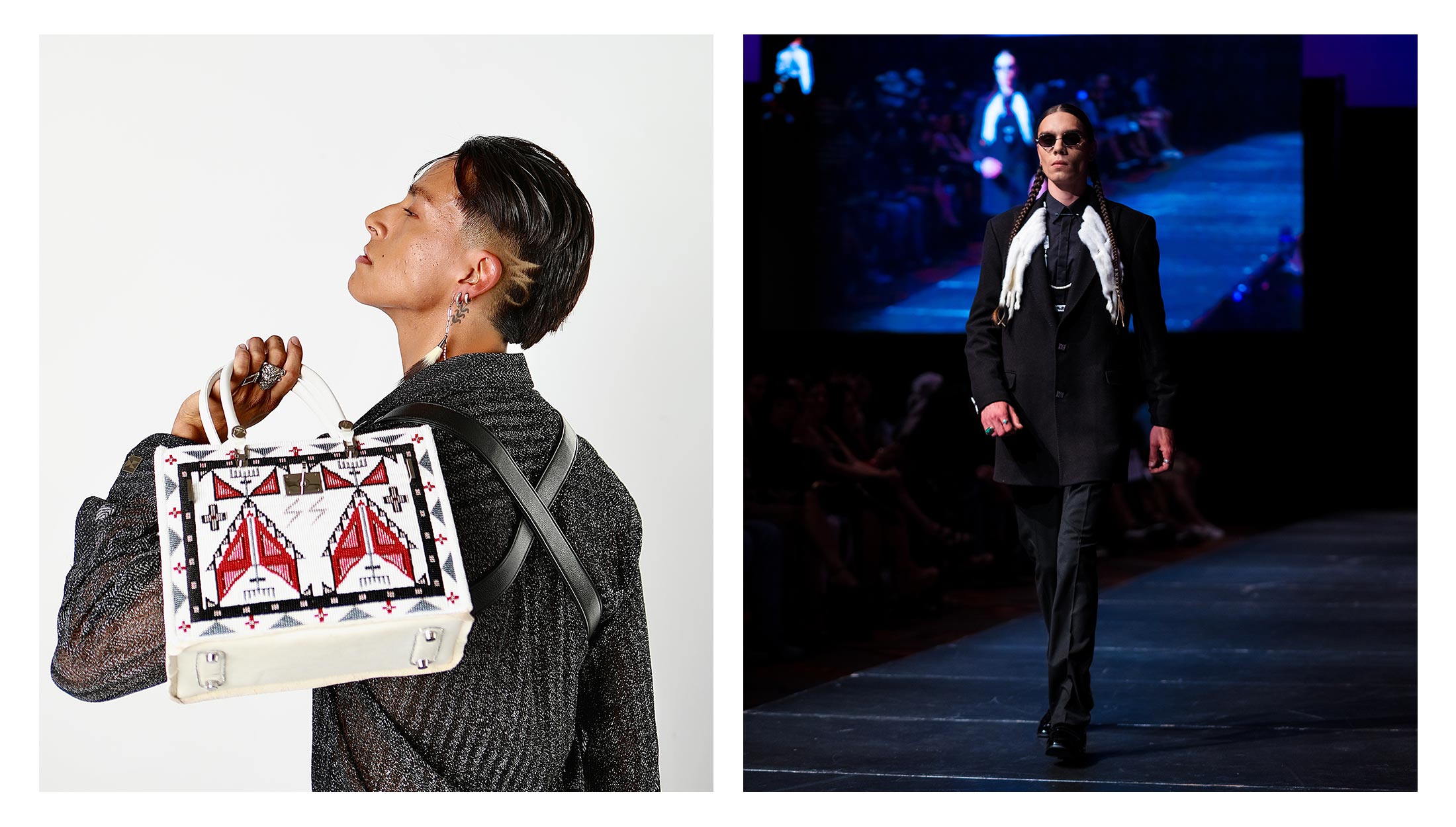
Beloved Santa Fe and Taos Pueblo local, Patricia Michaels of PM Waterlily, brought us the final presentation of the evening, with her collection titled Weaving Through Time. The collection featured warm oranges, pinks, and earth tones paired with turquoise and coral jewelry.
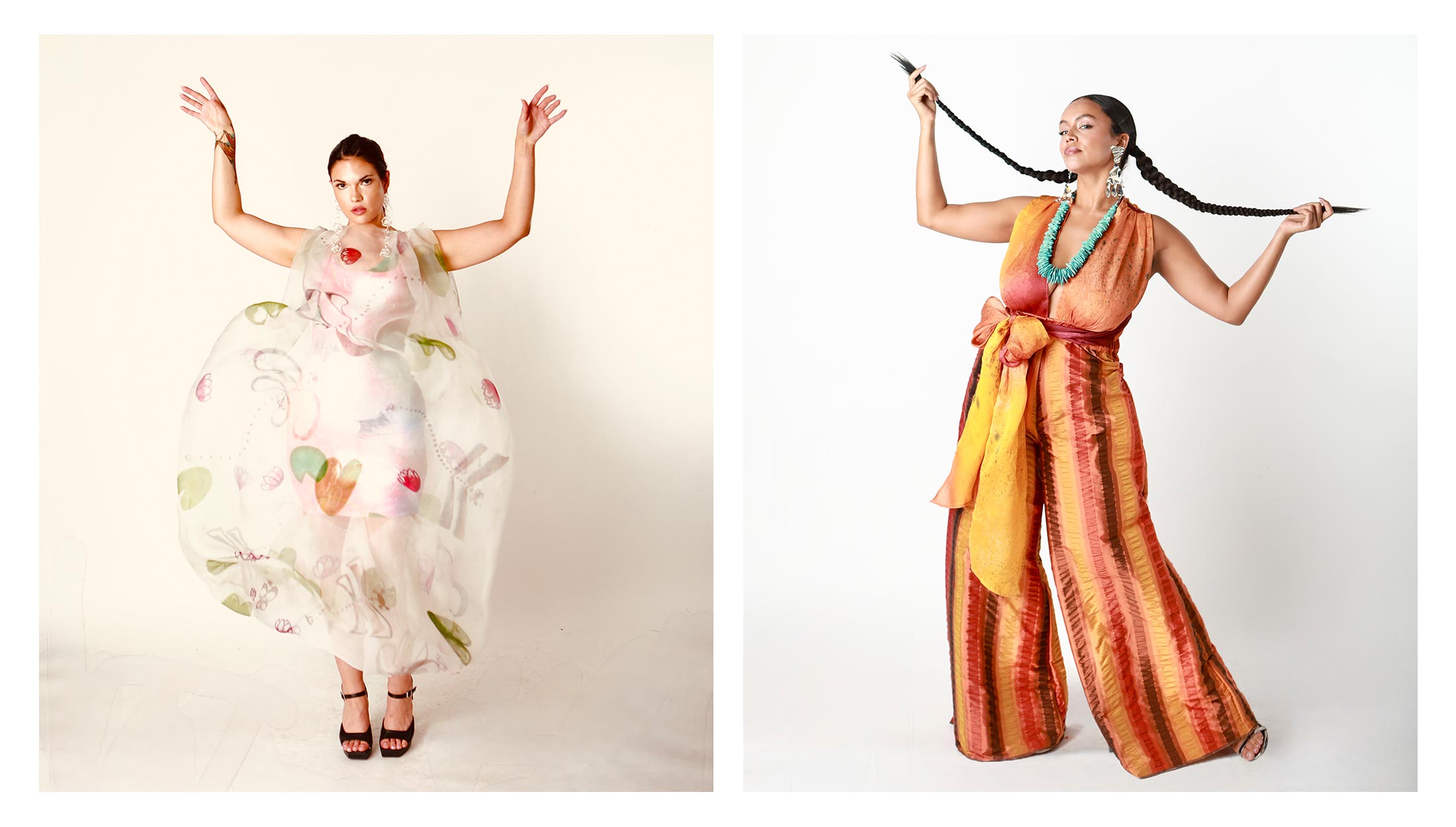
Known for her abstract draping, Patricia’s looks grew more sculptural with each piece. The final model of the evening, Deb Haaland, former U.S. Secretary of the Interior and current candidate for New Mexico Governor, stepped onto the runway.
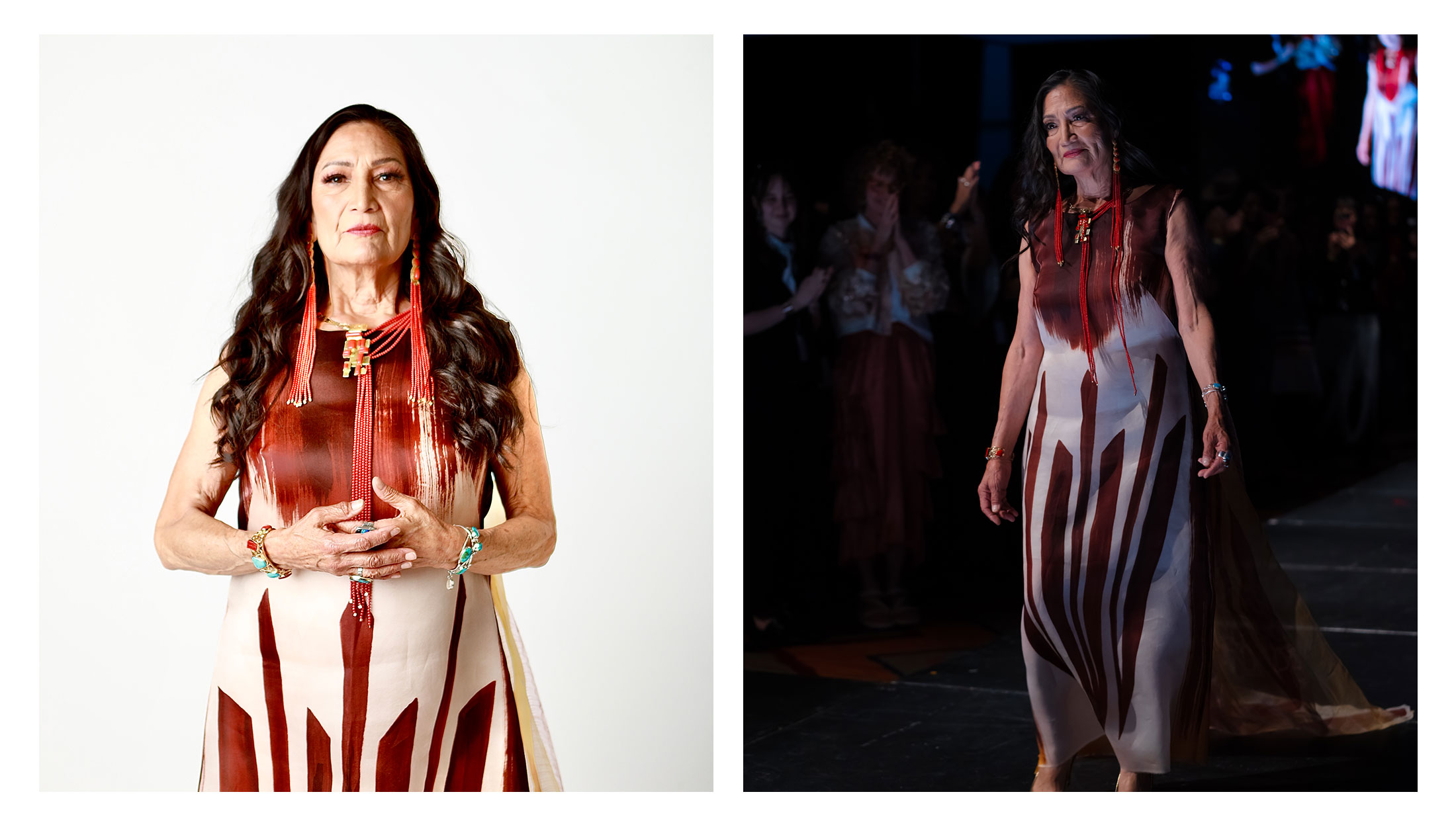
She wore a flowing gown with earthen red details and a silk train. Her appearance elicited cheers and a standing ovation from the audience, bringing the weekend’s events to an unforgettable close.
During SWAIA Native Fashion Week, the runway became a powerful platform, not only for showcasing artistry and design, but for reclaiming narratives and celebrating Indigenous brilliance.
"The things colonialism took from us were the fine-tuned technologies of the Indigenous people. But now, we are bringing it back to our lands," said Tishna Marlowe during a phone call. "Not long ago, it was illegal in Canada to participate in our culture, but now we are in a world where we are safe to sing our songs, dance our dances, and wear our clothes with pride."
This gathering was a powerful reminder that cultural heritage and futurism are not opposing forces, but threads woven tightly together. It displayed a re-making of stories, languages, and design into something alive and evolving.
In times marked by uncertainty and fear, gatherings like this offer more than beauty. They meet us with fresh perspectives, and they teach us that hope is not radical, but necessary. To experience SWAIA Native Fashion Week was to witness a renaissance in motion. It reminds us that tradition is not a relic of the past, but a living force, leading us forward.
"Ultimately, SWAIA is dedicated to creating economic sovereignty and career pathways for the artists we work with." Stated Jamie Schulze, executive director of SWAIA, in a brief interview.
Now in its second year, the SWAIA Native Fashion Week offered more than a showcase of garments. It stood as an affirmation of Indigenous presence, a cultural resurgence in motion. The fashion week has only grown in popularity, with over 20 designers from across North America, including several talented artists from Canada, presenting runway collections and pop-up events.
"Vancouver Indigenous Fashion Week and SWAIA are coming together to unite Indigenous fashion from North and South, telling our stories through art, culture and design. Through this partnership, we celebrate the revitalization of our traditions, the strength of our communities, and the power of fashion as a living expression of our identities" - Caroline Phelps, VIFW
The week served as a living canvas of tradition, storytelling, and innovation; it shows us that we are bearing witness to an Indigenous Renaissance.
"When people think of native fashion, they tend to envision ceremonial or powwow regalia, but there’s also so much more than that," said Schulze.The fashion week events began on Thursday with panel discussions at locations throughout the historic Santa Fe Plaza. The panels were led by academics and designers. The topics ranged from issues such as public health in Indigenous communities, to sustainability, innovation, and the future of Indigenous design in the fashion industry. The evening continued at the Governor’s Mansion in the Sangre de Cristo foothills, where designers, models, guests, and media had a chance to interact ahead of the weekend’s runway events.
It was pouring rain as guests arrived at the mansion. The house itself was warm and opulent, filled with people from all corners of North America, dressed in the finest bespoke tailoring, silver jewelry, furs, and beadwork. Room to room, the guests spoke with one another, some of them reuniting for the first time in several years.
"When people think of native fashion, they tend to envision ceremonial or powwow regalia, but there’s also so much more than that," said Schulze. "The reality is, Santa Fe has always been a major regional trade hub, and people have always dressed in their finest to come here."
I met Odo Ishkiin, an intern with SWAIA. He wore an upcycled Carhartt jacket, screen printed with his own design. Originally from Portland, Oregon, Odo came to Santa Fe to study with the Institute of American Indian Arts.
As the rain showers ended, a rainbow appeared in the mountains and people began to pour out into the surrounding grounds to get photos in the golden hour light. As I walked through the crowd, I came across Dene designer Tishna Marlowe of Dene Couture, arm in arm with Douma Alwarid of Unorthodox Yukon. Tishna was dressed in a black mesh top and trousers, Douma wore a red gown and was draped in a fur piece by designer Randi Nelson.

Photo Credit: Zoe Urness

Photo Credit: Zoe Urness
Tishna spoke about her upcoming Friday runway presentation, Dene Couture Heirloom Collection, and the future of Indigenous fashion overall. "I truly believe we are in the midst of an Indigenous Renaissance." she stated, looking at the crowd around us.
"This collection is a silent story of the growth of a genealogy." - Tishna MarloweThe runway events began on Friday evening, featuring presentations from Dancing Storm Designs, Stitched by April, Dene Couture, Sage Mountain Flower, Randi Nelson Designs, and Lauren Good Day. Inuk designer April Allen of Stitched by April presented a narrative story through her collection, accompanied by a live performance by Inuk-Mohawk throat singer Beatrice Deer. Randi Nelson’s Scwet̓mín̓ (Hide) Couture Collection consisted of traditionally tanned hides and furs, arranged in contemporary silhouettes.

Photo Credit: Veronica Huerta
Dene Couture, by Tishna Marlowe, presented a multifaceted collection, titled Dene Couture Heirloom Collection, distinguished by warm tones and rich textures. The final three pieces were characterized by featherlight skirts and structured bodices, embellished with intricate floral designs. When asked about her presentation, Tishna Marlowe explained the collection as an homage to her own matriarchal lineage. "This collection is a silent story of the growth of a genealogy."
She also spoke about the amount of time poured into each piece. "I bead everything from scratch. I don’t use patterns, which is why it’s couture. The corset alone on only one of my gowns took me over 5 weeks to complete."

Photo Credit: Veronica Huerta
Tishna Marlowe is Chipewyan, from an isolated community known as the Lutselke, ‘Place of the Small Fish,’ deep in the Northwest Territories in Canada. She was awarded the 2025 Banff Fleck Fellowship, and her residency will begin in September. "I consider myself a bridge between the old ways and the new. I am at a place in my life where I want to challenge myself to learn more technical skills to work with contemporary designs and blend it with the traditional skills that I have."
Marlowe dedicated her collection to her grandmother, Madeline Marlowe, and great-grandmother Marie Casaway. She explained that she was communally raised. "No matter where I went, there were beads on the table, hides, furs. My grandmother told me that as soon as I could crawl, I went right to the beads."

Photo Credit: Veronica Huerta
The Saturday afternoon runway show was characterized by powerful and hard-hitting presentations by Sacrd Thndr, VIVIDUS by Tierra Alysia, Snowfly, and Wabanoonkwe x Jennifer Younger.
VIVIDUS by Tierra Alysia presented a collection titled THUNDER ARRIVES, which was preceded by a message to the audience: "We are gathering across our lands, faster and stronger than ever before. Like a storm coming down from the heavens, we cannot be stopped."

Photo Credit: Veronica Huerta

Photo Credit: Veronica Huerta
The collection incorporated black, blue, and metallic hues along with sharp angles and beadwork to create a texturally rich body of work with a powerful message.
Snowfly, by Métis designer Cheryl Fennell, presented a vibrant collection with an arctic flair, featuring a blend of traditional and contemporary silhouettes, accompanied by a hazy psychedelic rock track. Each piece carried itself, but the icing on the cake was the final look: a copper toned embellished knee length dress, fur boots, and a shawl made of colorful metallic scales. The shawl glinted in the light, making a pleasing jingling sound as the model danced down the runway, appearing as though in flight.

Photo Credit: Sarah Jacobs
Wabanoonkwe, in collaboration with jewelry designer Jennifer Younger, showed a powerful collection titled Water Stories. The presentation brings attention to the communities of Wabasseemoong and Grassy Narrows, which have been facing devastating effects of mercury poisoning from industrial discharge for decades.

Photo Credit: Veronica Huerta
The runway looks featured silky, billowing gowns in various shades of black, blue, and white. The final look, a white gown and regal coral cape with a floral headpiece, was worn by model Sharn Maree Cassady (Ngāpuhi/Te Whānau-ā-Apanui) from New Zealand.

Photo Credit: Veronica Huerta
The evening runway featured collections by House of Sutai, Lesley Hampton, Ally's Ribbons, and TOC Legends. The show began with a speech and captivating performance by Cree hoop dancer James Jones, also known as Notorious Cree, which brought a vibrant energy to the remainder of the evening.
Lesley Hampton’s presentation was the most anticipated of the night. The 12-look collection, titled Obsidian: Lumina, began with bright pinks, soft and buttery textures, and unmistakable pleated skirts, a trademark of the brand. As the presentation progressed, the looks became characterized by darker, metallic hues and sharp silhouettes.

Photo Credit: Taylre Media
Earlier in the day, I had the chance to sit down and talk with Lesley about the collection. She said she had wanted this collection to be a representation of her journey in the fashion industry since starting her brand at the age of 22. "I was almost naive in thinking that I could come into the industry, especially the mainstream fashion industry, and be able to bring more inclusion and Indigenous representation… this collection reflects the naive innocence that I had when I started."
She explained her use of color and fabric, stating that the light pinks and flowy materials help to convey the innocence of her younger self, whereas the dark colors and hard lines work to convey a more mature, hardened version of herself.

Photo Credit: Taylre Media
As an Indigenous designer who wanted to create clothes for diverse bodies, Hampton stated she faced a lot of pushback early in her career. "It was a slow change at the beginning… but I’m really happy with how it is now. We are able to cast diverse, and there are other designers casting diverse. We’re all able to show, not only that all bodies are included in this space, but we as designers are actually working towards that."
James Jones opened the Sunday afternoon show with another Hoop Dance performance, this time accompanied by youth dancers with Lightning Boy Foundation, a local nonprofit founded in honor of Valentino 'Tzigiwhaeno' Rivera, a young dancer who lost his life after a tragic accident. Lightning Boy Foundation operates throughout the Tewa Pueblos of Northern New Mexico, giving local youth opportunities to learn traditional art forms and dance styles.
The afternoon runway presentations followed the hoop dancers’ performance, featuring collections by Towering Stone, K Lookinghorse, Kaylyn Baker Designs, Suglit Lukxs Designs, and Copper Canoe Woman. Towering Stone, by designer Loren Aragon of Acoma Pueblo, presented a collection of everyday luxury menswear. Standing Rock Sioux designer Kayla Smith, of K Lookinghorse, presented her 2025 collection titled Painted Skies. K Lookinghorse’s final look was a gown famously worn by model Quannah Chasinghorse during 2024 NYFW.

Photo Credit: Veronica Huerta
"An evolution of my last collection, Written in the Stars, Painted Skies delves deeper into Ready-to-Wear and Streetwear adaptations of these stories. The Written in the Stars collection highlights the Kapemni philosophy—'What is on earth is in the stars, and what is in the stars is on earth'—giving life to the idea that what is above reflects what is below."
The final runway event on Sunday evening featured presentations by RVSO78, Stevens & Snyder, Robyn McLeod, and PM Waterlily. It was the liveliest show by far, beginning with a performance by singer Mato Wayuhi (Reservation Dogs), joined on stage by James Jones and Tohono O’odham dancer Ba’ac Garcia of Red Boy Productions. During the performance, audience members stood and danced, while some of the SWAIA and VIFW staff hugged, danced, and shed tears near the back of the room, celebrating a successful weekend. Following Mato Wayuhi’s performance, Toronto-based Ballet dancer Madison Noon, of the Thunderchild Cree First Nation, mesmerized the crowd with a stunning performance, which led into the first runway presentation by RVSO78. The collection, titled Vision Quest, is characterized by bold modern streetwear looks.
"The things colonialism took from us were the fine-tuned technologies of the Indigenous people. But now, we are bringing it back to our lands," said Tishna Marlowe during a phone callPerhaps the audience’s most anticipated presentation was the Stevens & Snyder collection. The duo, Adrian Stevens and Sean Snyder, debuted their new menswear collection. The looks were sleek, fine tailored and paired with their signature jewelry line and beaded handbags. The duo won first-place ribbons at the 2024 SWAIA Indian Market for their beaded Birkin handbag, handcrafted from deer hide, featuring 24 karat gold seed beads, freshwater pearls, and ermine tail details.

Photo Credit: Zoe Urness & Veronica Huerta
Beloved Santa Fe and Taos Pueblo local, Patricia Michaels of PM Waterlily, brought us the final presentation of the evening, with her collection titled Weaving Through Time. The collection featured warm oranges, pinks, and earth tones paired with turquoise and coral jewelry.

Photo Credit: Zoe Urness
Known for her abstract draping, Patricia’s looks grew more sculptural with each piece. The final model of the evening, Deb Haaland, former U.S. Secretary of the Interior and current candidate for New Mexico Governor, stepped onto the runway.

Photo Credit: Zoe Urness & Veronica Huerta
She wore a flowing gown with earthen red details and a silk train. Her appearance elicited cheers and a standing ovation from the audience, bringing the weekend’s events to an unforgettable close.
During SWAIA Native Fashion Week, the runway became a powerful platform, not only for showcasing artistry and design, but for reclaiming narratives and celebrating Indigenous brilliance.
"The things colonialism took from us were the fine-tuned technologies of the Indigenous people. But now, we are bringing it back to our lands," said Tishna Marlowe during a phone call. "Not long ago, it was illegal in Canada to participate in our culture, but now we are in a world where we are safe to sing our songs, dance our dances, and wear our clothes with pride."
This gathering was a powerful reminder that cultural heritage and futurism are not opposing forces, but threads woven tightly together. It displayed a re-making of stories, languages, and design into something alive and evolving.
In times marked by uncertainty and fear, gatherings like this offer more than beauty. They meet us with fresh perspectives, and they teach us that hope is not radical, but necessary. To experience SWAIA Native Fashion Week was to witness a renaissance in motion. It reminds us that tradition is not a relic of the past, but a living force, leading us forward.
Join the Club
Follow the organizations you care about, track and bookmark events as they're announced—discover your next enriching experience on Ode.
